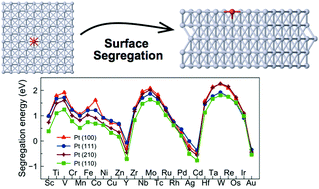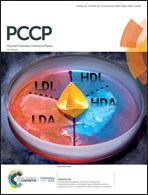First principles analysis of surface dependent segregation in bimetallic alloys†
Abstract
Stability is an important aspect of alloys, and proposed alloys may be unstable due to unfavorable atomic interactions. Segregation of an alloy may occur preferentially at specific exposed surfaces, which could affect the alloy's structure since certain surfaces may become enriched in certain elements. Using density functional theory (DFT), we modeled surface segregation in bimetallic alloys involving all transition metals doped in Pt, Pd, Ir, and Rh. We not only modeled common (111) surfaces of such alloys, but we also modeled (100), (110), and (210) facets of such alloys. Segregation is more preferred for early and late transition metals, with middle transition metals being most stable within the parent metal. We find these general trends in segregation energies for the parent metals: Pt > Rh > Pd > Ir. A comparison of different surfaces suggests no consistent trends across the different parent hosts, but segregation energies can vary up to 2 eV depending on the exposed surface. We also developed a statistical model to predict surface-dependent segregation energies. Our model is able to distinguish segregation at different surfaces (as opposed to generic segregation common in previous models), and agrees well with the DFT data. The present study provides valuable information about surface-dependent segregation and helps explain why certain alloy structures occur (e.g. core–shell).



 Please wait while we load your content...
Please wait while we load your content...